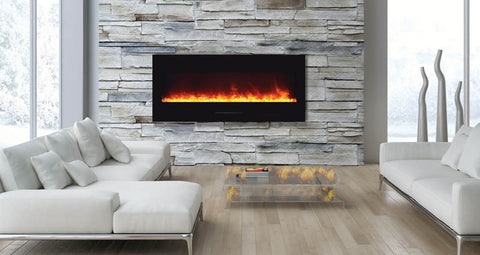
Electric Fireplace versus Central Heat:
Depending on the age of your home, the quality of windows and insulation, the setup of your central heating system, etc., getting a consistent temperature in every room of your house can be challenging.
Imagine this scenario. You own a 2 story home in a colder climate. During the winters, the upper level is always colder than the main floor where your family spends most of their time.
The problem is, your bedroom is on the upper level. Heading up to a freezing bedroom at night is no fun, but neither is the cost of keeping your thermostat set 4 degrees higher just to address this issue. Instead you’ve come up with a different solution…

Using an electric fireplace for heat:
Now when you head up at night you immediately switch on your electric fireplace, which works quickly in a small space like the bedroom. It can have your room feeling noticeably warmer before you’re even done brushing your teeth.
By the time you’re actually ready for bed, the room is warm and you can turn the fireplace off. This is a solution I’ve been using in my own home for the past 3 years. I have a wall mounted electric fireplace, and I usually only need to have it running for 5-10 minutes before it’s warmed the room enough.
This is known as “zone heating”. By being able to just heat the area or room we need, we avoid the more expensive option of turning the thermostat up, affecting the whole house. According to the U.S. Department of Energy, heating and cooling account for 48% of the energy use in a typical home, which makes it the number one energy expense for most homeowners.

So what does an electric fireplace cost to run?
The typical 1500W electric fireplace unit running on high heat with flame effects will cost roughly $0.18/hour.
While the cost of electricity varies around the country, for the sake of simplicity, if you had your fireplace running on high heat for a full hour each day for a month, you could expect your electric bill to rise about $5.40.
Contrast that with the cost of your heating bill if you keep the thermostat a few degrees warmer for a month.

Electric Fireplace versus Wood Burning Fireplace:
Don’t get me wrong, a traditional wood burning fireplace can’t be beat when it comes to ambiance and overall coziness factor.
Unfortunately, with that come with a couple significant downsides.
- Not efficient. This is actually the least efficient option. While the actual fire does get hot, most of that heat heads right up the chimney. Worse than that, it actually creates a draft effect in your home, where warm air is being pulled into the fire to feed it. It can actually decrease the warmth of your house by up to 25%.
- Cost of operation. In addition to the cost of wood, there are ongoing maintenance costs with keeping the chimney clean and fireplace safe to use.
Instead of letting their traditional wood burning fireplace sit vacant, many people choose to renovate that space with an electric fireplace insert. It fits right into the open fireplace space and makes a much more efficient option.



















